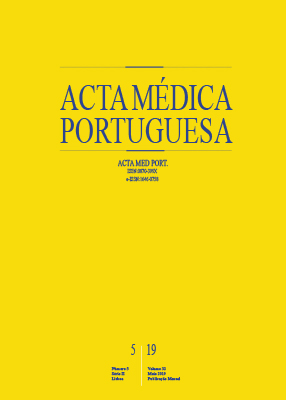Global Impact of Peripheral Obstructive Arterial Disease in Portugal: An Eight Year Study
DOI:
https://doi.org/10.20344/amp.10822Keywords:
Arterial Occlusive Diseases/epidemiology, Peripheral Vascular Diseases/epidemiologyAbstract
Introduction: Peripheral arterial disease has an important impact on morbidity/mortality. The objective of this study was to quantify the impact of this disease in Portugal during the last eight years, expressed by the volume of admissions, treatment strategies and associated morbidity and mortality.
Material and Methods: We collected data from the Diagnosis Related Group national database on primary diagnosis, procedures codes, demographic variables, a number of risk factors, and mortality of all cases admitted from 2009 to 2016 with a primary diagnosis of peripheral arterial disease coded according to the 9th revision of the International Statistical Classification of Diseases and Related Health Problems (ICD-9).
Results: In this study, peripheral arterial disease led to 27 684 hospitalisations, which corresponded to 26.7% of all admissions for vascular disease in this period. Approximately 49.9% of patients were admitted to the emergency department. The volume of procedures in patients with claudication decreased over the eight years, unlike patients with critical ischaemia, in which the number of procedures increased.
Discussion: Age and the presence of cardiovascular risk factors have been associated with the severity of disease, as observed in our series. Overall hospital mortality varied, being significantly higher in patients with more advanced severity of the disease.
Conclusion: Peripheral arterial disease represents an important burden in the overall volume of admissions in Portuguese public hospitals. A large number of patients was admitted in the context of emergency.
Downloads
Downloads
Published
How to Cite
Issue
Section
License
All the articles published in the AMP are open access and comply with the requirements of funding agencies or academic institutions. The AMP is governed by the terms of the Creative Commons ‘Attribution – Non-Commercial Use - (CC-BY-NC)’ license, regarding the use by third parties.
It is the author’s responsibility to obtain approval for the reproduction of figures, tables, etc. from other publications.
Upon acceptance of an article for publication, the authors will be asked to complete the ICMJE “Copyright Liability and Copyright Sharing Statement “(http://www.actamedicaportuguesa.com/info/AMP-NormasPublicacao.pdf) and the “Declaration of Potential Conflicts of Interest” (http:// www.icmje.org/conflicts-of-interest). An e-mail will be sent to the corresponding author to acknowledge receipt of the manuscript.
After publication, the authors are authorised to make their articles available in repositories of their institutions of origin, as long as they always mention where they were published and according to the Creative Commons license.









